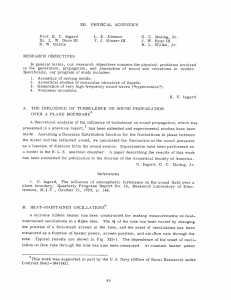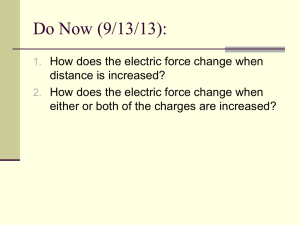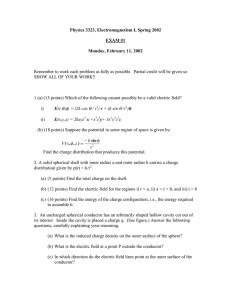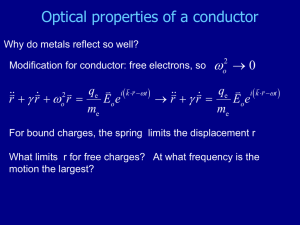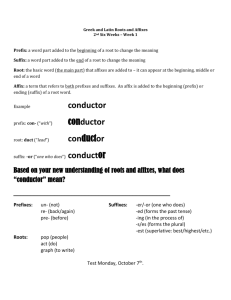VIII. PHYSICAL ACOUSTICS
advertisement
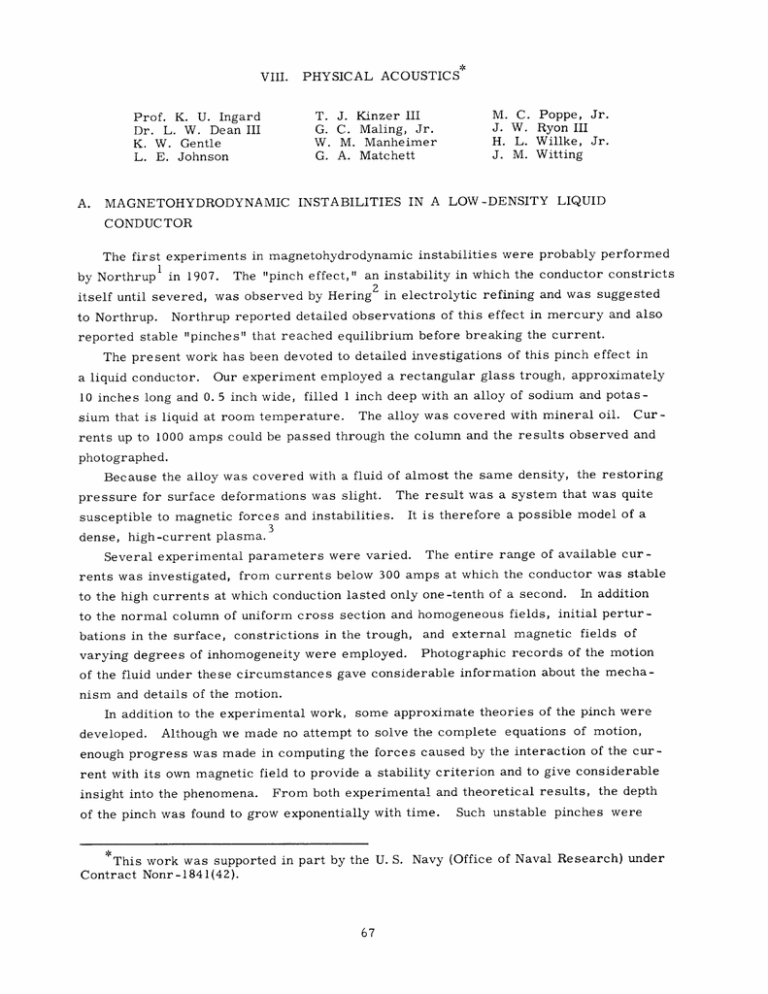
VIII. T. G. W. G. Prof. K. U. Ingard Dr. L. W. Dean III K. W. Gentle L. E. Johnson A. PHYSICAL ACOUSTICS MAGNETOHYDRODYNAMIC J. Kinzer III C. Maling, Jr. M. Manheimer A. Matchett M. J. H. J. C. Poppe, Jr. W. Ryon III L. Willke, Jr. M. Witting INSTABILITIES IN A LOW-DENSITY LIQUID CONDUCTOR The first experiments in magnetohydrodynamic instabilities were probably performed by Northrupl in 1907. The "pinch effect," an instability in which the conductor constricts 2 itself until severed, was observed by Hering in electrolytic refining and was suggested Northrup reported detailed observations of this effect in mercury and also to Northrup. reported stable "pinches" that reached equilibrium before breaking the current. The present work has been devoted to detailed investigations of this pinch effect in a liquid conductor. Our experiment employed a rectangular glass trough, approximately 10 inches long and 0. 5 inch wide, filled 1 inch deep with an alloy of sodium and potas- sium that is liquid at room temperature. The alloy was covered with mineral oil. Cur- rents up to 1000 amps could be passed through the column and the results observed and photographed. Because the alloy was covered with a fluid of almost the same density, the restoring pressure for surface deformations was slight. The result was a system that was quite susceptible to magnetic forces and instabilities. dense, high-current plasma. It is therefore a possible model of a 3 Several experimental parameters were varied. The entire range of available cur- rents was investigated, from currents below 300 amps at which the conductor was stable to the high currents at which conduction lasted only one-tenth of a second. In addition to the normal column of uniform cross section and homogeneous fields, initial perturbations in the surface, constrictions in the trough, and external magnetic fields of varying degrees of inhomogeneity were employed. Photographic records of the motion of the fluid under these circumstances gave considerable information about the mechanism and details of the motion. In addition to the experimental work, some approximate theories of the pinch were developed. Although we made no attempt to solve the complete equations of motion, enough progress was made in computing the forces caused by the interaction of the current with its own magnetic field to provide a stability criterion and to give considerable insight into the phenomena. From both experimental and theoretical results, the depth of the pinch was found to grow exponentially with time. Such unstable pinches were This work was supported in part by the U. S. Navy (Office of Naval Research) under Contract Nonr-1841(42). (VIII. PHYSICAL ACOUSTICS) observed for all currents above 400 amps, the threshold of instability as experimentally determined and theoretically indicated. However, the time constant of the growing exponential is a complex function of current, dimensions of the conductor, and shape of the pinch for which no functional dependence is given. A homogeneous fluid conductor is most certainly unstable with respect to small perturbations when the current exceeds a certain critical value. Careful examination of the experiments and theory indicate also that if the conductor is unstable for small perturbations, it will be even more unstable for large constrictions. We concluded that no stable pinches will be formed in a homogeneous conductor. A paper with a more detailed description of these studies is in preparation. K. W. Gentle, U. Ingard References 1. E. E. Northrup, Some newly observed manifestations of forces in the interior of an electric conductor, Phys. Rev. 24, 474 (1907). 2. C. Hering, A practical limitation of resistance furnaces, the pinch phenomenon, Trans. Am. Electrochem. Soc. 11, 329 (1907). 3. B. Lehnert and G. Sjbgren, A liquid conductor model of the hollow pinch, Nuclear Energy: Part C 1, 121-123 (1960). B. GENERATION OF SHOCK WAVES BY EXPLODING WIRES A high-voltage facility for the study of exploding wires and similar phenomena has been completed. It consists of 8 banks, each with sixteen 3. 75-4F Sprague 10-kv oilbath discharge capacitors, giving a total of 60 FF for each bank. The capacitors are connected with a large sheet of aluminum which forms the ground plate of the back. Terminals of a capacitor bank are connected to large metal sheets separated by a mylar sheet. The capacitors are charged. The discharge is triggered by means of a gap switch that is caused to break down by means of a trigger pulse of 15 kv. Shock waves produced by exploding wires in air at atmospheric pressure have been studied. Copper wires 1. 5 inches long and ranging in diameter from 0. 3 mm to 0. 7 mm have been used. The voltage on the wires has been varied from 2 kv to 5. 5 kv. The energy spectrum of the shock waves has been determined up to a frequency of 50 kc, and the efficiency of energy conversion to the shock wave has been measured. We found that a maximum power efficiency of approximately 3 per cent was obtained for a diameter of 0. 5 mm when the voltage was 5 kv. The duration of the "N-type" wave was approximately 0. 5 msec, and the maximum pressure measured at a distance of 30 cm was approximately 0. 1 atmosphere. A paper on these studies is in preparation. L. E. Johnson, U. Ingard PHYSICAL ACOUSTICS) (VIII. C. MAGNETICALLY DRIVEN SHOCK WAVES IN SOLID CONDUCTORS Preliminary experiments on the excitation of magnetically driven shock waves in conducting solids have been undertaken. magnetic field of a single-turn coil through which a large current (approximately The other end of the bar was attached to a quartz-crystal 60, 000 amps) was discharged. transducer. The end of a copper bar has been placed in the Shock waves in the bar were observed, and the attenuation of these waves was measured in copper. The generation of shock waves in electrolytes is now being attempted, in the same manner. U. Ingard SOUND PROPAGATION IN Cu3Au D. The alloy Cu 0 390 C. 3 Au exhibits an order-disorder transition at a critical temperature of As the temperature is raised, the ordering of atoms in the lattice decreases slowly at first, then rapidly, and vanishes altogether at the critical temperature. Previous measurements 1 at the critical temperature have shown that the attenuation of a 600-kc sound wave is approximately 0. 05 nepers per cm. More recent measure- ments indicate that the attenuation at 2 mc may be more than ten times this amount. More exact measurements will be made when the problem of how to couple the sound wave to the sample over the necessary range of temperature has been solved. A. L. W. Dean III, G. Matchett References 1. P. M. Scop, An Investigation of Order-Disorder Transitions in Cu3Au by Acous- tic Techniques, S. B. Thesis, Department of Physics, M. I. T., E. FIELD MEASUREMENTS May 25, 1959. OF SOUND PROPAGATION OVER GROUND Field measurements performed to check some theoretical calculations on the influence of a plane boundary on sound propagation in an inhomogeneous moving medium have been completed. In order to simplify comparison of experiment with theory, we decided that the measurements should be performed over a large rigid boundary. parking lot of Lincoln Laboratory, M. I. T., The main was used for the experiments described below. Tape recordings of the received sound pressure level were made as a function of the distance from an electromagnetic horn driver. placed 4 ft above the ground level. Both driver and microphone were Frequencies of 500, and measurements were made on three different days. 1000, and 2000 cps were used, The rms data follow the theo- retical curves reasonably well, except in the minima of the pressure pattern at which (VIII. PHYSICAL ACOUSTICS) the effect of the turbulence is to raise the rms level, as discussed in Quarterly Progress Report No. 64 (page 59). The fluctuations, however, are much more irregular than those obtained in the R. L. E. anechoic chamber. In order to try to obtain better corre lation with the theoretical calculations, other statistical properties of the received signal (for example, the standard deviation) are being calculated. G. C. Maling, Jr., U. Ingard


